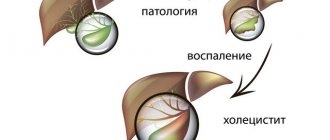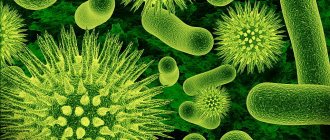The time has come for summer holidays, which is also the long-awaited season of fresh berries, vegetables and fruits, swimming in the gentle waters of rivers and seas, and... intestinal infections. Unfortunately, the peak incidence of infectious intestinal diseases occurs during the warm season. High air humidity, heat, food contaminated with microbes, lack of personal hygiene and violation of food storage rules contribute to the spread of infectious agents. The most common diseases among the population, called intestinal infections, are dysentery and salmonellosis.
What should you know about dysentery? How to protect yourself and your loved ones from this infection? We will talk about this and much more today in this article.
Dysentery is an infectious disease that occurs with intestinal damage and intoxication.
With the light hand of Hippocrates, this infectious disease received the name “dysentery” (from the Greek “dys”, which means “disorder”, and “enteron”, which means “intestines”). In Ancient Rus', the disease was called “bloody womb”, and today the disease is called shigellosis because of the name of the pathogens - Shigella - from a large and “friendly” family of enterobacteria.
Ways of transmission of the disease
The source of intestinal infection is patients with dysentery or bacteria carriers, that is, people who have no manifestations of the disease, but are infectious to others.
The causative agents of this acute intestinal infection enter the body with food, water, through contaminated household items, dishes, toys and unwashed hands.
Infection occurs due to non-compliance with personal hygiene rules - dysentery, typhoid fever, helminthiasis, cholera, salmonellosis and hepatitis A are diseases of “dirty hands”.
You can also become infected with dysentery by swimming in polluted waters.
Quite often the cause of the disease is our carelessness. You finished eating expired yogurt or bought shawarma on the beach - what’s wrong with that? For some it may be nothing, but for others such an experiment with their health may result in treatment.
Dysenteric geography
Bacterial dysentery is more common in European countries, amoebic dysentery - in India and Mexico.
Tourists planning a trip and getting vaccinated against dysentery should not forget about this.
It has been observed that children, adolescents and people with chronic diseases are more susceptible to bacillary dysentery.
Sonne's dysentery is most often caused by dairy products contaminated with bacteria; Flexner's dysentery is transmitted through contaminated water; amoebic dysentery can be “caught” by eating unwashed vegetables, herbs, and contaminated water.
In addition, the causative agent of dysentery is carried by cockroaches and flies.
The disease more often “makes itself known” in the summer-autumn period, since it is at this time that the most favorable conditions are created for the spread of yersiniosis, dysentery and salmonellosis.
Infectious disease doctors warn that the most dangerous dish in the summer is salads dressed with mayonnaise! Almost all foods that have not been heat-treated can pose a health risk - for example, raw eggs, shellfish, sushi, milk, vegetables and herbs.
Is lifelong immunity formed after suffering from dysentery?
Unfortunately no. The immunity of a person who has recovered from the disease is only temporary and lasts 4-12 months. After this, the possibility of re-infection cannot be ruled out.
The main way to prevent intestinal infections is frequent hand washing, washing fruits and vegetables, and preference for heat-treated food.
The good news is that with improved hygiene standards (especially in 2021 due to the COVID-19 epidemic) and literacy in antibiotic prescribing, the incidence of dysentery is on the decline. Vaccines against some of its pathogens are also being developed. And perhaps in the future humanity will be able to get rid of this dangerous disease. MAKE AN APPOINTMENT PRICES
Forms of dysentery
- bacterial carriage (can be detected accidentally);
- acute dysentery lasts up to three months;
- Chronic dysentery lasts more than three months.
Dysentery in adults, both acute and chronic, can have a mild, moderate or severe course of the disease. In children, signs of dysentery are accompanied by severe intoxication and dehydration.
Acute dysentery
Like any infectious disease, acute dysentery has a certain incubation period, that is, a period of time during which bacteria enter the body and multiply there, as in an incubator. On average, the incubation period can last about 1-2 days.
Most often, acute dysentery occurs with damage to the large intestine, but there are variants of the disease when the stomach and small intestine are involved in the inflammatory process.
After the incubation period, the period of the height of the disease begins - the first symptoms appear. In adults, fever, chills, headache, weakness and drowsiness appear. Each bowel movement is preceded by paroxysmal abdominal pain. The patient notes pain during and after defecation. The feces are liquid, mixed with mucus and blood. During the day there can be up to 100 urges to recover, although the number of bowel movements is small. Concerned about heartbeat, decreased blood pressure, poor appetite.
With inflammation of the upper gastrointestinal tract, nausea, watery diarrhea, and vomiting occur.
Depending on the severity of the disease, this period lasts about a week.
Symptoms in children develop against the background of severe intoxication. Frequent urges to go to the toilet exhaust the child, he is lethargic, refuses food, and cannot swallow liquid. There are signs of severe dehydration: no urination, no sweat, no tears, dry skin and tongue. The baby may complain of chills, abdominal pain, and headache.
Parents need to understand that an insidious infection can cause serious harm to the child’s health. Therefore, when the first manifestations of an intestinal infection appear, it is necessary to urgently call an ambulance or consult a pediatrician. Before the doctors arrive, it is necessary to dehydrate the baby and reduce intoxication by giving him Enterosgel sorbent.
As a result of the treatment, acute manifestations of the disease gradually fade away and recovery occurs. Less commonly, the process becomes chronic.
Chronic dysentery
Chronic dysentery in adults has a relapsing course, as doctors say, that is, it consists of periods of exacerbation and relative well-being. Exacerbation of the disease is caused by seasonal acute infections of the upper respiratory tract and errors in diet. The severity of symptoms during the exacerbation period is less than in the acute form. Intoxication is less pronounced, the body temperature rises to 37.5°C, diarrhea, defecation is less painful, and there is not always blood in the stool.
Chronic dysentery in children and adults can be accompanied by anemia, hypovitaminosis, dysbacteriosis, weight loss, insomnia, and anorexia.
Dysentery in children is often complicated by urinary tract infection, bronchitis and pneumonia.
Do newborns get dysentery?
Unfortunately yes. Children in the first year of life can also develop this disease. The risk group includes:
- premature babies;
- low weight babies;
- with anemia;
- rickets;
- diathesis;
- children who are bottle-fed.
Diagnostics
If you have symptoms of the disease, it is recommended to consult a doctor. An upset stomach and intestines is a reason to visit a gastroenterologist's office, especially if it occurs on a regular basis. A specialist will be able to make an accurate diagnosis after conducting a comprehensive diagnosis, which includes interviewing the patient, visual examination, passing the necessary tests and undergoing diagnostic procedures. Based on the data obtained, the doctor will be able to accurately make a diagnosis.
Atypical manifestations of dysentery
- erased form of the disease - characterized by minor intestinal symptoms and lack of intoxication, so patients rarely seek medical help;
- fulminant form - severe intoxication, acute renal failure;
- gastroenterocolitic form - its manifestation resembles foodborne toxic infection.
Symptoms and treatment depend on the type of pathogen. Shigella Sonne often causes bacterial carriage and the disease caused by this pathogen occurs in the form of a foodborne toxic infection. Shigella Grigorieva-Shiga causes severe dysentery, with severe intoxication and intestinal symptoms, while Flexner's shigellosis is characterized by a milder course of the disease.
What diseases should the disease be differentiated from?
Treatment of dysentery in adults begins after other diseases have been excluded: bacterial and viral intestinal infections, amoebiasis, ulcerative colitis, colon cancer.
With amoebic dysentery (amebiasis), the stool looks like “raspberry jelly”, the disease occurs without severe intoxication and significant fever.
With salmonellosis, bowel movements are not accompanied by painful or false urges, and the feces look like swamp mud.
Cholera is accompanied by profuse diarrhea and dehydration, and the stool has the appearance of rice water. Abdominal pain, fever and false urges are not typical.
With typhoid fever, the liver and spleen are enlarged, and there are rashes on the skin.
With nonspecific ulcerative colitis and colon cancer, there are characteristic changes in the mucous membrane of the large intestine. The diagnosis is established after instrumental examination.
What else is prescribed with this study?
Clinical blood test with leukocyte count and ESR (with microscopy of a blood smear to detect pathological changes) (venous blood)
3.9.1. Ven. blood 1 day
460 ₽ Add to cart
Coprogram
21.2. Feces 1 day
360 ₽ Add to cart
Culture for intestinal pathogens (Shigella spp., Salmonella spp.)
123.0. Feces, smear 4 days
650 ₽ Add to cart
Culture for yersinia (Yersinia spp.)
132.0. Feces 12 days
650 ₽ Add to cart
Shigella, Escherichia, Salmonella, Campylobacter, DNA (Shigella spp., E. coli (EIEC), Salmonella spp., Campylobacter spp., PCR) feces, quality.
19.53. Feces 2 days
850 ₽ Add to cart
Treatment
The main principle is the earliest possible start of therapeutic measures.
Treatment of dysentery in children is carried out in the infectious diseases department. Adults with mild forms of the disease can be treated at home, while adults with severe and moderate forms of dysentery are treated in a hospital. What therapeutic measures do doctors use against dysentery?
Medical nutrition
Diet therapy plays an important role. In the acute stage of the inflammatory process, a therapeutic diet low in carbohydrates and fats is prescribed. Patients take food 5-6 times a day in small portions. Foods that cause bloating are not recommended.
Products recommended by nutritionists:
- pureed vegetable soups;
- wheat crackers;
- fish soups;
- omelet, soft-boiled eggs;
- white bread crackers;
- boiled lean meat or fish;
- porridge with water (oatmeal, rice).
Foods that doctors advise to exclude from the diet:
- fatty meats and rich broths;
- flour products;
- fresh bread;
- salted fish;
- sausage;
- pearl barley and millet porridge;
- pasta;
- beans, peas;
- jam, compotes;
- fresh vegetables and fruits;
- milk;
- coffee.
Drug therapy
The main drugs against dysentery are antibiotics. In some cases, a polyvalent bacteriophage is also prescribed. The duration of the course of antibiotics is up to 7 days.
To remove bacterial toxins from the body, patients are prescribed Enterosgel sorbent.
Taking antidiarrheal medications is contraindicated for the patient! These medications slow down the removal of the pathogen from the intestines.
After a course of antibiotic therapy, intestinal dysbiosis is treated and the normal bacterial picture of the intestine is restored. If necessary, vitamins, antihistamines and immunostimulants are prescribed. If food digestion is impaired, digestive enzymes are prescribed.
Comprehensive treatment of dysentery in children includes:
- combating dehydration - drinking plenty of fluids, saline solutions;
- bed rest;
- fight against intoxication (Enterosgel);
- therapeutic diet;
- antibacterial therapy;
- enzymes;
- To reduce intestinal discomfort, Enterosgel is recommended;
- prebiotics and probiotics to restore intestinal microflora.
Children in the recovery stage are prescribed vitamins, decoctions of medicinal herbs, medications that increase the body's defenses, and spa treatment.
Preventive actions
Infection can be prevented by observing basic hygiene. Prevention of dysentery includes:
- washing hands before eating;
- proper storage and adherence to cooking technology;
- mandatory boiling of milk and water before consumption;
- isolation of a patient with dysentery, thorough disinfection of his linen and utensils;
- preventive examination of catering workers to exclude bacteria carriage;
- isolation of sick children, ban on visiting kindergartens and schools until complete recovery and negative stool culture results.
Prevention
Outbreaks of infection with dysentery bacteria most often occur in the summer, especially during the ripening of strawberries, raspberries, and grapes. Therefore, it is necessary to thoroughly wash fruits, vegetables and berries before eating.
The microorganism retains high vital activity in raw water, unboiled milk, expired products (or those that were improperly stored). Parents need to monitor the quality of food their child eats.
It is important to isolate the patient from healthy family members and to monitor the cleanliness of his hands (namely, after visiting the toilet). He must use separate toys, dishes, towels, and linen.
Shigella is also carried by flies. It is necessary to ensure that these insects do not enter the house or land on various objects and food.










